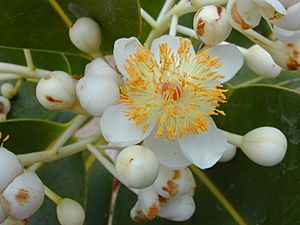Calophyllum inophyllum facts for kids
Quick facts for kids Calophyllum inophyllum |
|
|---|---|
 |
|
| Conservation status | |
| Scientific classification | |
| Genus: |
Calophyllum
|
| Species: |
inophyllum
|
The Calophyllum inophyllum is a large evergreen tree. It is often called tamanu, mastwood, beach calophyllum, or beautyleaf. This tree grows naturally in warm parts of Asia and Wallacea.
Long ago, people from the Austronesian groups spread this tree. They moved to islands in Oceania and Madagascar. They carried the tree because its wood was very important for building large outrigger ships. Today, you can also find it growing wild along the coast of East Africa. The tree is also known for its special tamanu oil, which has many cultural uses.
Contents
What are its other names?
Calophyllum inophyllum has many other names around the world. Some of these include Alexandrian laurel balltree, beach touriga, and Indian-laurel. In places like Island Southeast Asia and Oceania, it's often called bintangur, bitaog, tamanu, or kamani.
What does it look like?
The tamanu tree grows slowly and has many branches. Its top part, called the crown, is wide and not perfectly shaped. It usually grows to be about 8 to 20 meters (26 to 66 feet) tall.
Its flowers are about 25 millimeters (1 inch) wide. They grow in groups of four to 15 flowers. The tree can flower all year, but it usually has two main flowering times. These are in late spring and late autumn.
The fruit of the tamanu tree is called a ballnut. It is round and green, measuring 2 to 4 centimeters (0.8 to 1.6 inches) across. Inside, it has one large seed. When the fruit is ready, it looks wrinkled and changes color from yellow to brownish-red.
Where does it grow?
The Calophyllum inophyllum tree is native to many places. These include countries in Africa like Comoros, Kenya, and Madagascar. It also grows in parts of Asia, such as Bangladesh, China, India, Indonesia, and Japan. You can also find it in the Pacific Region, including the Cook Islands, Fiji, and Samoa. It also grows in Australia, in the Northern Territory and Queensland.
Today, people grow this tree in many warm, tropical areas around the world. It is popular as an ornamental plant because of its pretty leaves, sweet-smelling flowers, and wide crown.
This tree often grows near the coast and in lowland forests. But it can also grow well inland, even at medium heights. It can grow in different types of soil, like sandy beaches, clay, or even poor soil.
How do people use it?
Building boats
The mastwood tree is special because it can grow very large on sandy or rocky beaches. Its big branches often curve out over the water. This helps its seeds spread with the ocean currents.
Because of these features, mastwood was very important for traditional shipbuilding. The Austronesian peoples used it to build their large outrigger ships. They even carried the tree with them when they moved to Oceania and Madagascar. Other trees from the Calophyllum family were also used. These trees were as important to Austronesian shipbuilding as oak trees were to European shipbuilding.
Different parts of the mastwood tree were used to build outrigger canoes. The large, curved branches were often carved into the main body of the canoe, which is like the keel of a ship. Other parts of the tree became masts, outrigger floats, and spars. Smaller curved branches could also be used for the boat's ribs.
In many parts of Polynesia, groups of mastwood trees planted in sacred places called marae were considered holy. People believed spirits lived there. Mastwood was also carved into religious objects like tiki statues. The tree is often mentioned in old chants and stories.
In Australia, a book from 1889 noted that the mastwood tree was protected. A law was made to stop people from cutting down or harming these trees on Thursday Island. This law helped the local people.
Other uses for the tree
Besides shipbuilding, tamanu oil from the fruit kernels was very important in Polynesian culture. This oil, along with pastes made from the leaves and flowers, was often used in traditional medicine.
The leaves of the tree contain things that are harmful to fish. So, they can be used as fish poison. The sap from the tree is also poisonous. In Samoa, it was used to make poison arrows. The ripe fruit is poisonous enough to be used as bait for rats.
The seeds give a thick, dark green tamanu oil. This oil can be used for medicine or for hair. The nuts are dried before they are cracked open. Then, the oily kernel inside is taken out and dried more.
In Kerala, India, a tribe called the Mavilan uses the bark of the tree. They make a powder from it, mix it with water, and put it on plants that are sick from too much water.
The oil from C. inophyllum seeds can also be used to make biodiesel. This biodiesel meets important quality standards in the United States and the European Union. One tree can produce about 11.7 kilograms (25.8 pounds) of oil. In the Philippines, this oil was used for night lamps. Its use decreased when kerosene and later electricity became available. During World War II, it was even used as fuel to power radios.
Images for kids
See also
 In Spanish: Calophyllum inophyllum para niños
In Spanish: Calophyllum inophyllum para niños





